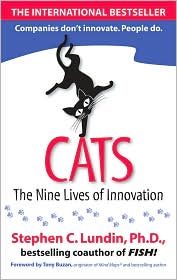


May 2009
In this Issue:
|
Say
It Quick |
Discoveries bits of serendipity to inspire and motivate |
Ideas fuel for your own continuous learning |
Activities tips and tricks you can try today |
| Writer's Block | CATS: The Nine Lives of Innovation | Preparation | Switch Off |
In this story of just 99 words, read an example of how one person got her creativity moving again. Then learn more about how to stay in a creative flow in Discoveries below.
Writer’s
Block
Kate was stuck in her writing and stuck in the snow. Her words fell like slush
and the wet, heavy snow outside made her back ache. But the walk had to be
shoveled. Grumbling under her breath, she dug into the snow again.
Then she noticed the gently drifting snowflakes and crisp, silent air. She took a deep breath of winter, chose to be present in the moment, and felt her body relax.
With the rhythm of physical work, she entered a state of flow and finished quickly – gaining new ideas for her writing in the process!
 CATS:
The Nine Lives of Innovation
CATS:
The Nine Lives of Innovation
by Stephen Lundin
The saying goes that curiosity killed it. But in his book, CATS, Stephen Lundin turns that old adage upside down by using cat-like characteristics as an analogy for the essence of innovation.
Lundin's slim, readable book describes the nine lives (essential ingredients) of innovation. These lives are embodied in CATS, people who seek consciously to become better at innovating. Lundin asserts that it doesn't make sense to try to figure out how innovative organizations work when it's actually the individuals within an enterprise that bring about creative change.
To that end, his book focuses on the nine essential factors that foster innovation:
In CATS, a chapter is devoted to each of the nine lives. Concepts are illustrated with straight forward examples, some of which span several of the nine lives so readers quickly appreciate the holistic nature of the innovative process. Lundin also takes some time to identify and demystify the challenges to innovation that tend to block our creativity.
Not content with theory, Lundin seems bent on provoking readers to boost their own innovative abilities. Chapters at the end of the book offer creativity tools, concepts, practice activities, and the opportunity to earn an innovation CAT Belt. And you can find more CAT culture on the web.
Rather than fearing curiosity, CATS embrace it and innovate – as I urge you to do through Lundin's book! Learn more at his web site: http://www.catsinnovation.com
Preparation
Imagine listening to a jazz band at a nightclub. During a long number the
saxophonist, drummer, bass player, and piano player, all take a turn improvising.
Each gets a limited number of measures to play whatever they want. Each gets
their moment in the spotlight. Imagine, too, what it must take to perform
solo, before a live audience, doing something you're creating on the spot
which also must somehow fit with what the group has already been doing.
To do that you need knowledge about music history and theory. You need a certain skill level and confidence. You need a finely tuned sense of aesthetics. You need to have had both successes and failures. To be succinct, you need to be prepared.
Preparation is one of the Lundin's conditions for innovation. In CATS he argues that continually refining one's knowledge, skills, and expertise builds a storehouse filled with experiential knowhow. Then, when the need or desire for creation arises, you've got all the materials right at hand.
Innovation doesn't come from nowhere. It's the synergy that occurs when experience, knowledge, skill, and ideas encounter each other in new ways. If you want to become more creative, learn more about what you already know. Review your knowledge base from time to time. Refine skills so you can achieve fluency. Then, when it's your turn for the spotlight, you'll be ready to improvise!
Switch Off
One of Lundin's observations in CATS is that innovators learn to become wary
of what's normal. Routines keep us from becoming paralyzed by the need to
constantly make decisions. They make daily living easier – but that's the
problem! When we're on autopilot we are more likely to coast past opportunities
for creative expression. Innovators, on the other hand, are willing to shake
up their routine. They know that to be creative is to break familiar paradigms.
So here is this month's activity: break a routine and see what new possibilities and perspectives it opens for you. Here's some inspiration.
Find a fun way to switch your autopilot off. Then, when you discover something new, please . It just might be what I need to switch off my autopilot and innovate! -– Brian
Read previous
issues. Click Archives!
To add or delete your name to our mailing list, email
with a short note in the subject line.
We want this newsletter to be practical, succinct, and thoughtful. If you have suggestions about how we can meet these criteria, please let us know! Send us an with your thoughts and ideas.
Home
| Services
| Products
| Mission
| Ideas |
The Group
| The Buzz
(c)
2005 The Firefly Group